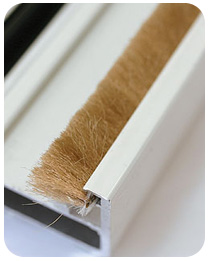|
Weather Stripping |
 |
Weather Stripping
Tips
Pile Weather Strips are closely woven
textile yarns interlaced into a
backing.
Weatherstripping is the process of
seal of
openings such as
windows and doors. The
purpose
of
the
weatherstripping is
to protect
rain and water
from entering by blocking it
to
outside or by returning or rerouting it.
The second purpose
of
Weather Stripping
is to keep interior air in, thus saving energy
with heating and air conditioning.
Choose a type of weatherstripping that
will withstand the friction, weather,
temperature changes, and wear and tear
associated with its location. For example, when
applied to a door bottom or threshold,
weatherstripping could drag on carpet or erode
as a result of foot traffic. Weatherstripping in
a window sash must accommodate the sliding of
panes—up and down, sideways, or out. The
weatherstripping you choose should seal well
when the door or window is closed while allowing
it to open freely.
You can use more than one type of
weatherstripping to seal an irregularly shaped
space. Also take durability into account when
comparing costs. See Table 1 below for
information about the common types of
weatherstripping.
Choose a product for each specific location.
Felt and open-cell foams tend to be inexpensive,
susceptible to weather, visible, and inefficient
at blocking airflow. However, the ease of
applying these materials may make them valuable
in low-traffic areas. Vinyl, which is slightly
more expensive, holds up well and resists
moisture. Metals (bronze, copper, stainless
steel, and aluminum) last for years and are
affordable. Metal weatherstripping can also
provide a nice touch to older homes where vinyl
might seem out of place.
|
|
|